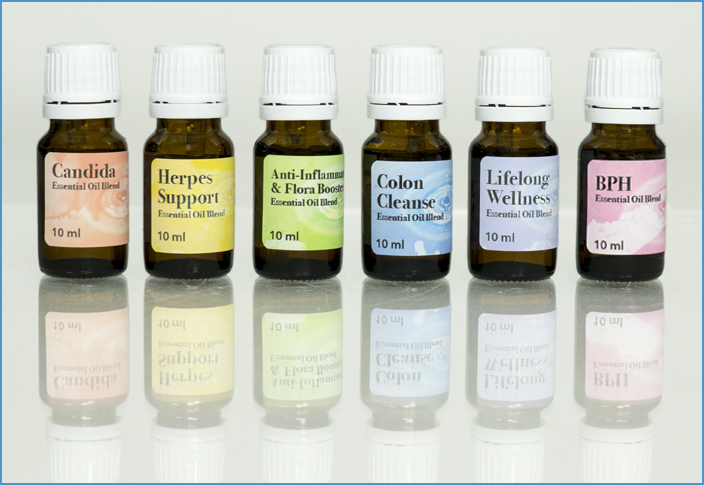How To Make Coconut Oil Rectal Suppositories with Therapeutic Essential Oils
Jump to Products
Ingredients and Supplies
Instructions
What Are Essential Oil Suppositories For?
Essential oils are transporters of fundamental nutrients necessary to feed and nurture all the cells of the body.
Delivered via rectal suppository, essential oil implant recipes support healing from hemorrhoids, anal fissures, yeast infections, and other colon-related ailments, and more broadly support a healthy colonic mucosa.
Essential oil suppositories can also help men effectively support their prostate health.
▶︎ View Hemorrhoid Suppository Kit
▶︎ View Anal Fissure Suppository Kit
▶︎ View Prostate Suppository Kit
▶︎ View Candida (Yeast Balance) Suppository Kit
According to drug delivery research by the National Institutes of Health, because the colon is highly absorptive, suppositories have several advantages over other delivery methods, including increasing bioavailability to absorbable tissue, bypassing first pass metabolism, the ability to deliver higher doses of drug or therapeutic essential oils, and avoidance of irritation to the gastric mucosa. Furthermore, suppositories can deliver treatments and drugs to produce both local and systemic impact.
Because it can be both a liquid and a solid, coconut oil is an ideal carrier oil for do-it-yourself (DIY) suppositories, facilitating the absorption of other oils.
▶︎ Read Important Cautions and Disclaimers

Supplies and Ingredients
- Rounded 21-cube Suppository Tray
- Organic Virgin Coconut Oil
- Targeted essential oils or blends based on your health challenges. Examples:
- respiratory support: Breathe Ease and/or Deep Breathe
- yeast balance support: OHN Candida EO Blend
- diverticulitis support: OHN Hemorrhoid EO Blend, Tummy Rub EO Blend, and/or OHN Colon Cleanse EO Blend
- irritable bowl (IBS) support: peppermint, wintergreen, spearmint, fennel, orange, ginger, cypress, grapefruit, and/or lemon
- leaky gut support: lemon, orange, Citrus Passion EO Blend, grapefruit, fennel, lavender, rosewood, frankincense
- prostate support: OHN BPH EO Blend or OHN Prostatitis EO Blend
▶︎ View additional essential oil support suggestions
How To Make Essential Oil Suppositories
- In a rounded 21-cube suppository tray, fill each cube of the tray 1/3 to 1/2 full of coconut oil. (At cooler temperatures, coconut oil is solid, so you may need to first set your coconut oil in hot water to melt it.) After you've filled each cube, put the tray in the freezer for 1 to 2 hours.
- Remove the suppository tray from the freezer.
- Carefully dispense your essential oil drops onto the top of the frozen coconut oil in each cube. The amount of essential oil needed depends on which oils or oil blends you are using and what issue you are working with in the body. See our suppository recipes for recommended amounts of essential oils. Generally, we recommend 2 to 3 drops per essential oil. Sometimes a single suppository might have up to 8 different oils in its mixture. In this case, you would use a total of 6 to 10 drops of the essential oils.
- Once the essential oil is dispensed onto the top of the frozen coconut oil, fill up the rest of the each cube with more coconut oil.
- Put the tray back into the freezer, and in a couple of hours you will be ready to use your first therapeutic suppository!
NOTE: You don't need to make only one type of essential oil rectal suppository per tray. Rather, you can make a variety, as essential oils are best used in rotation. In other words, alternate different oils on different days. For example, one day you might use frankincense and orange, and another day you might use OHN's Candida Essential Oil Blend, which contains lavender, bergamot, lemongrass, and eucalyptus globulus.
How To Make Essential Oil Suppositories
Kristina Amelong, CCT, CNC provides step-by-step instructions on how to make coconut oil suppositories with therapeutic essential oils. She discusses the benefits of essential oil suppositories and health challenges which can be supported, including hemorrhoids, anal fissures, candida overgrowth, prostatitis, BPH, irritable bowel syndrome (IBS), and more.
Insertion into the Rectum
- Pop one coconut oil suppository out of the tray by pushing up on the bottom of the individual cube.
- Place the suppository on a small plate. You will see that it has a rounded edge that allows for easy insertion into the rectum.
- Leave the suppository on the plate for 5 to 10 minutes to allow it to soften slightly before you insert it into your rectum.
- With your fingers, gently insert the suppository into the rectum, rounded edge forward. The suppository is self-lubricating: as soon as it touches a warm part of your body, it begins to melt.

Therapeutic Essential Oils and Colon Health
Even though the suppository may look large to you, it is easy to insert. You will find that it just slides right into the rectum. Some people find the size of the suppository to be daunting, but the rectum is just like a tightly closed mouth and has a tremendous capacity to open.
Note: If possible, insert the suppository after a bowel movement or after an enema series.
Most people do not leak when they use these coconut oil suppositories. It is best to try your first suppository on a day when you can easily get to the bathroom or to wear a sanitary pad. Some people find it best to use the suppository while they sleep. If you don't know whether you will leak, sleep on a towel your first night of using a suppository.
If you find that the suppositories cause you to be gassy, you will want to work to optimize the types of bacteria that live in your colon, as gas from a suppository may indicate high levels of unhealthy microorganisms such as Candida albicans.
▶︎ BROWSE ALL ESSENTIAL OILS AND BLENDS
DISCLAIMER: The Optimal Health Network offers therapeutic products and protocols to support your health under the supervision of your doctor. This material is presented for informational purposes only and is not a substitute for medical advice, diagnosis, or prescribing from a licensed healthcare professional. We make no claim or guarantee for cure or relief of any specific symptom, medical condition, or disease when using any of these products or protocols. DO NOT attempt to self-diagnose or self-prescribe any natural substances for health conditions that require professional attention.

▶︎ Need more detailed guidance in preparing suppositories at home?
Personal Health Consultations with
Kristina Amelong, CCT, CNC
For personalized support with your home health program, I would be happy to assist via a scheduled phone consultation. I charge an affordable $2.25 per minute, for as many or as few minutes as you need!
First complete any relevant sections of my secure online intake form. Upon submitting the form, you will be prompted to schedule a consultation time with me via my online booking system.
If you are an international client who would like to use WhatsApp for your scheduled consultation, please email us for instructions on how to contact me at the time of your consultation.
|
|
▶︎ BROWSE ALL ESSENTIAL OILS AND BLENDS
IMPORTANT CAUTIONS & DISCLAIMERS
We strongly advise you to consult with your medical doctor or a knowledgeable health practitioner before using any essential oils internally to ensure a safe and optimal program for your individual body. When planning to introduce a new essential oil into your healthcare program, test one drop on a small patch of skin first (e.g., on the underside of the forearm). Sensitivity to particular essential oils is highly individual. If the skin feels hot or turns red, this indicates sensitivity, and this essential oil or blend should NOT be used in your healthcare program. Apply a vegetable oil (e.g., olive or almond) to the area, which will dilute the essential oil. Washing with water is less effective. Apply only one new essential oil or blend at a time to the patch of skin to determine how your body responds. Wait 30 minutes before testing another new essential oil. DO NOT attempt to self-diagnose or prescribe any natural substances for health conditions that require professional attention. Consult your healthcare professional about any serious disease, medical condition, or injury, or if you are pregnant, nursing, or planning to become pregnant. DO NOT use wild tansy, clary sage, sage, fennel, wintergreen, or hyssop essential oils during pregnancy.
LATEX ENEMA BAGS: Do not use essential oils in latex (rubber) enema bags. Essential oils degrade latex over time. Use essential oils only in silicone, stainless steel, or plastic enema equipment.
|
|
|